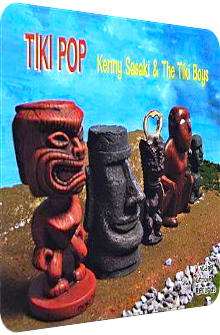
Kenny Sasaki & The Tiki Boys
Tiki Pop
2005
The second album of Tokyo-based film musician and Exotica afficionado Kenny Sasaki unites him once more with his faux-band The Tiki Boys, and say what you will about his iridescent stylistic variations, but Tiki Pop, released in 2005, takes the cake: it is his technicolored, sun-laden and euphoria-driven album with a pinch of jungle field recordings, the catchiest melodious riffs, a strong surf attitude and shedloads of euphonious compositions which altogether augment the concept of Exotica and take it to lush green lands.
This stellar release doesn't degrade Sasaki's other albums – the darker and mysterious debut Tiki Moon of 2002 and the third release Island Slumber of 2010 with its warped steel guitars, sophisticatedly spectral funk layers and phantasmagoric plasticity –, but Tiki Pop opens a window into the condensed realms of Sasaki; here he presents a tropical savoir vivre and juxtaposes it to glowing-afternoon hammock skits and Surf Rock banters, and he does it with ease and joy. The positive vibe of the album makes it the perfect companion for daytime activities such as travels or beach walks. It is also an effervescent companion to his other albums.
The album opens with the flowing exhilarance of Jungle River which is to this day the best tune Sasaki came up with – two exclamation marks follow!! This meandering river captures the essence of modern Exotica: a field recording of water, various birds of paradise and monkeys launches the track and is immediately accompanied by gentle maracas, a rumbling bass guitar line and the lush vibraphone sustains that get more quirky and more complex later on. Once the catchy riffs of the surf guitar enter the scene, a Hermosa Beach feeling of strolls and coolness is undoubtedly introduced to the track. Best of all is the field recording that only stops for a short while but is otherwise ubiquitously audible throughout the song.
This is Exotica in a nutshell: surf guitars, vibraphones, bird noises and gorgeous melodies. Is there anything missing? Nope. An über-perfect track and a benchmark or blueprint respectively that remains stuck in my head. If Sasaki's best track ever is featured as the intro, it must go downhill from this point on, right? Of course not, thanks to Jill The Spy with her carefree and careless attitude loaded with tremendously rocky surf guitars, funky backings and a glaring nastiness that is usually found in albums of Exotica heroes like Clouseaux. The eerie in-your-face spy flavor of this song is huge, the drum kit is beaten to the max, the tempo is rough and quick and the staccato gourd-like guitar melody adds a pinch of Sicilian stereotypes to the mix without destroying the sneaky presentation. Very vivid and punchy, this song evokes the feeling of a real band setup perfectly, but is actually done bit by bit by Sasaki alone.
While Bikini Banzai picks up the surf mood but boosts its dimensions with a wonky eight-note bass guitar layer, hand claps and less melodious but nonetheless terrific surf guitar improvisations, Ponape educes the tempo for the first time and returns into the dreamlands of Tiki Moon, but places them into a glowing-red dusk reverie with the shimmering polyphony of – you guessed it – surf guitars that inherit bits of the mean coolness factor of the previous tracks. The laissez-faire attitude is then merged with a certain echoey lightheartedness. Slow Ride, as its title suggests, is a similarly easy-going piece that puts the heavily reverberated bongos into the limelight. The surf guitars have lost their coolness in favor of a tremendously dreamy style that is further bolstered by short vibraphone accompaniments. My top pick in terms of the slower sacrifices Sasaki offers.
Erotica Exotica is the Latin track on the album and continues the artist's tradition of presenting at least one track per album in that style. The typical Latin piano tone sequences point to a melancholic lamento complete with xylophones and the unsuspected addition of a warmly oscillating Hammond organ which transports a vintage flavor and interweaves it into the mix. The bouncy steel guitar tries to add a Hawaiian flavor, but ultimately fails due to the dominance of all the other ingredients.
Torches is a gorgeous nocturnal ditty with a hectic vibraphone that plays the convoluted melody in a gloomy Far Eastern style, implying the danger and excitement of the hottest element known to man. The freely floating guitars add to the Japanese flavor, making this the singular night-time affair of an otherwise cyan-tinted album, and sure enough does the following five minute long Kaanapali hark back to the neo-Polynesian style by painting a sumptuous cove with a bold bass guitar line, laid back but sometimes crunchy acoustic guitars. At times the song moves into melancholic territories, but it is brightly lit and definitely not keen on the heavy kind of nostalgia.
Beach Bunny is a catchy interlude of two minutes with cool echoey surf guitars, space opera laser sounds, short bursts of a Moog synthesizer or a similarly tweaked organ, whereas the penultimate track Margarita is a heavyweight of a good-humored bongo-laden guitar-organ coupling that blends glints of Latin sequences with a strong performance on the whirling, piano-backed organ.
The closing track Aliens In Honolulu is of particular interest for me, as Sasaki knows a thing or two about outro tunes that enhance the style of the respective album without breaking it to pieces. The track deliberately insists on a jazzy Lo-Fi approach with sizzling-hot organ sustains, deliberately cheap castanets, various synthesizer backings and an astonishingly memorable main melody on both an organ and a guitar. This song perfectly resembles the 16-bit video game culture and could have been featured in a cheesy credit roll sequence of a ludicrous beat 'em up game. The mood is content, happiness ensues and everyone is satisfied. A gorgeous outro, so unlike anything else that came before it, but definitely suitable for transporting both Sasaki's Japanese heritage and the romance of vintage Exotica. And off the air we go, with a blast!
Tiki Pop is Kenny Sasaki's surf album. This is the short description that would do the album justice. A longer explication would tell you about its additional strengths that consist mainly of catchy melodies, a great interplay between mallet and string instruments as well as the occasional warmth of the organs, the appearance of clichéd but welcome Latin and Far Eastern tone sequences and the interdependency of various kinds of coolness and coziness, all of them related to the surf approach. Even when Sasaki's performance is presumably based on a jam session, the results are as catchy as they are punchy. Add a dose of field recordings and digital bleeps to the table, and you receive the aural sunbeams of Tiki Pop as a successful treat(ment).
The good mood cannot be stopped or destroyed, and even when melancholia arrives or the nastiness of the surfers' attitudes increases, there is no doubt about the generous bliss the eleven songs encapsulate and set free resplendently. If you want to listen to one of the finest Exotica compositions in recent times, take the opener Jungle River into account. Fans of Latin music go with Erotica Exotica, while otakus of Nippon will embrace Torches. And finally, if you long for the Japanese quirkiness of a rudimentary setup, the closer Aliens In Honolulu will enhance your mood likewise. As I recommend all of Sasaki's albums, you know my viewpoint of Tiki Pop anyway. Go get this album on iTunes or Amazon and support future vivid compositions of this talent!
Exotica Review 080: Kenny Sasaki & The Tiki Boys – Tiki Pop (2005). Originally published on Jun. 9, 2012 at AmbientExotica.com.
